


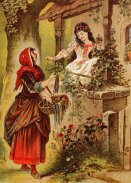
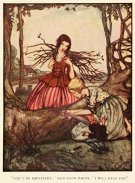
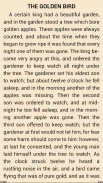
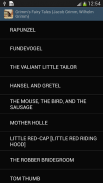
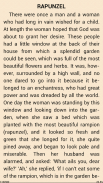
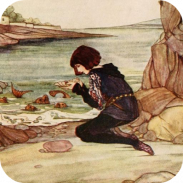
Grimms' Fairy Tales in English

Deskripsi Grimms' Fairy Tales in English
Children's and Household Tales (German: Kinder- und Hausmärchen) is a collection of German fairy tales first published in 1812 by the Grimm brothers, Jacob and Wilhelm. The collection is commonly known in the Anglosphere as Grimm's Fairy Tales (German: Grimms Elfenmärchen).
The Brothers Grimm (or Die Gebrüder Grimm), Jacob (1785–1863) and Wilhelm Grimm (1786–1859), were German academics, linguists, cultural researchers, lexicographers and authors who together collected and published folklore. They are among the most well-known storytellers of folk tales, popularizing stories such as "Cinderella" "(Aschenputtel)", "The Frog Prince" ("Der Froschkönig"), "Hansel and Gretel" ("Hänsel und Gretel"), "Rapunzel", "Rumpelstiltskin" ("Rumpelstilzchen"), and "Snow White" ("Schneewittchen"). Their first collection of folk tales, Children's and Household Tales (Kinder- und Hausmärchen), was published in 1812.
The brothers spent their formative years first in the German town of Hanau. Their father's death in 1796, (when Jacob was eleven and Wilhelm ten), caused great poverty for the family and affected the brothers for many years. They both attended the University of Marburg and at the same time developed a curiosity for folklore, which grew into a lifelong dedication to collecting German folk tales.
A fairy tale is a type of short story that typically features European folkloric fantasy characters, such as fairies, goblins, elves, trolls, dwarves, giants, witches, mermaids, or gnomes, and usually magic or enchantments. Fairy tales may be distinguished from other folk narratives such as legends (which generally involve belief in the veracity of the events described)[1] and explicitly moral tales, including beast fables.
In less technical contexts, the term is also used to describe something blessed with unusual happiness, as in "fairy tale ending" (a happy ending) or "fairy tale romance" (though not all fairy tales end happily). Colloquially, a "fairy tale" or "fairy story" can also mean any farfetched story or tall tale; it's used especially of any story that not only isn't true, but couldn't possibly be true.
Anak-anak dan Tales Rumah Tangga (Jerman: Kinder-und Hausmärchen) adalah kumpulan dongeng Jerman pertama kali diterbitkan pada tahun 1812 oleh Grimm bersaudara, Jacob dan Wilhelm. Koleksi ini umumnya dikenal di Anglosphere sebagai Fairy Tales Grimm (Jerman: Grimms Elfenmärchen).
The Brothers Grimm (atau Die Gebrüder Grimm), Jacob (1785-1863) dan Wilhelm Grimm (1786-1859), adalah akademisi Jerman, ahli bahasa, peneliti budaya, lexicographers dan penulis yang bersama-sama dikumpulkan dan diterbitkan cerita rakyat. Mereka adalah salah satu pendongeng yang paling terkenal dari cerita rakyat, mempopulerkan kisah-kisah seperti "Cinderella" "(Aschenputtel)", "Pangeran Kodok" ("Der Froschkönig"), "Hansel dan Gretel" ("Hansel und Gretel") , "Rapunzel", "Rumpelstiltskin" ("Rumpelstilzchen"), dan "Snow White" ("Schneewittchen"). Koleksi pertama mereka cerita rakyat, Anak dan Rumah Tangga Tales (Kinder-und Hausmärchen), diterbitkan pada tahun 1812.
Saudara-saudara menghabiskan bertahun-tahun formatif pertama mereka di kota Jerman Hanau. Kematian ayah mereka pada tahun 1796, (ketika Yakub adalah sebelas dan Wilhelm sepuluh), menyebabkan kemiskinan yang besar untuk keluarga dan mempengaruhi saudara selama bertahun-tahun. Mereka berdua kuliah di University of Marburg dan pada saat yang sama mengembangkan rasa ingin tahu untuk cerita rakyat, yang berkembang menjadi dedikasi seumur hidup untuk mengumpulkan cerita rakyat Jerman.
Sebuah dongeng adalah jenis cerita pendek yang biasanya fitur karakter Eropa folkloric fantasi, seperti peri, goblin, elf, troll, kurcaci, raksasa, penyihir, putri duyung, atau apalah, dan pesona biasanya sihir atau. Dongeng dapat dibedakan dari cerita-cerita rakyat lainnya seperti legenda (yang umumnya melibatkan keyakinan akan kebenaran dari peristiwa yang dijelaskan) [1] dan secara eksplisit cerita moral, termasuk dongeng binatang.
Dalam waktu kurang konteks teknis, istilah ini juga digunakan untuk menggambarkan sesuatu yang diberkati dengan kebahagiaan yang tidak biasa, seperti dalam "dongeng berakhir" (happy ending) atau "dongeng romance" (meskipun tidak semua dongeng berakhir bahagia). Bahasa sehari-hari, sebuah "dongeng" atau "dongeng" juga bisa berarti setiap cerita dibuat-buat atau dongeng; itu digunakan terutama dari setiap cerita yang tidak hanya tidak benar, tetapi tidak mungkin benar.

























